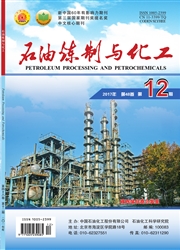

 中文摘要:
中文摘要:
通过实沸点蒸馏装置按组分沸点将抚顺页岩油切割成5个窄馏分,测定每个馏分元素组成、残炭、碱性氮含量等基本性质;又利用红外光谱和’H—NMR谱图,通过昏L法计算各馏分的平均结构参数;再通过GC-MS对各馏分饱和分、芳香分的组成进行定性定量分析;最后考察随馏分沸程升高其催化裂化性能的变化。结果表明:随馏分沸程升高,其密度、残炭增大,页岩油氮元素及碱氮含量均远高于常规原油;且馏分越重,其芳碳率、侧链平均长度越大,三环及以上稠环芳烃所占比例越大;此外,较重馏分催化裂化结焦严重,但较轻馏分裂化反应的产物分布较为理想,说明页岩油具有催化裂化/JOT.潜力。
 英文摘要:
英文摘要:
Shale oil was separated into five narrow-cuts by true boiling point distillation. The prop- erties of the narrow-cuts, including elemental composition, carbon residue and basic nitrogen content, were tested. Base on the characterizations of infrared spectrometry and nuclear magnetic resonance, the average structure parameters of the narrow-cuts were calculated using Brown-Ladner method. The con- tents of saturate and aromatics in each narrow-cut were quantitatively measured. And the comparative evaluations were set to investigate the catalytic cracking performance of different narrow-cuts. The results show that as the boiling range of narrow-cut rises, the density and carbon residue increases, and the contents of both nitrogen and basic nitrogen in shale oil are higher than conventional crude oils. It is found that the heavier the narrow-cut, the higher the aromatic ratio and the longer the average length of side chain, and the larger ratio of condensed aromatics with three rings and above. Although the crack- ing of heavy narrow-cut leads to severe coking, the product distribution of light narrow-cuts is reasona- ble, indicating that shale oil has a potential for catalytic cracking processing.
 同期刊论文项目
同期刊论文项目
 同项目期刊论文
同项目期刊论文
 期刊信息
期刊信息
